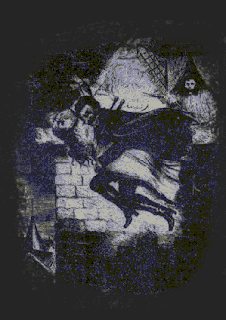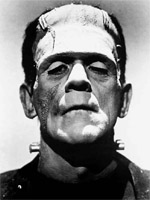Named for his unique ability to jump great distances and heights, Spring Heeled Jack was said to have clawed hands and eyes that resembled “red balls of fire”. Some accounts describe the creature wearing a black cloak, a helmet and a white oilskin garment that fit tightly over his tall and thin frame. Many stories give him Devil-like features and the ability to breath out blue and white flames and at least two accounts claimed that he could actually speak English.
According to legend, Spring Heeled Jack was first spotted in London in 1837 by a businessman walking past the Barnes Cemetery. He claimed to have seen a mysterious creature jump with impossible ease over the cemetery railings and landed in his path. He described what he saw as muscular man with pointed ears and nose and protruding eyes that glowed like the fires of hell.
He was spotted a few more times that year but soon his appearances began turning into attacks, mainly on women. Two cases in particular helped spark the panic and fear of the elusive Spring Heeled Jack, that of Jane Alsop and Lucy Scales.
Jane Alsop – On the night of February 18, 1938, Jane heard a knocking at the door and a man’s voice calling out: “I'm a police officer-for God's sake, bring me a light, for we have caught Spring Heeled Jack in the lane.” Eager to assist, Miss Alsop ran out to the man to give him a candle. The man was wearing a large black cloak and a helmet. When the man brought the candle towards him, she noticed that his eyes resembled “red balls of fire” and that he was spitting blue and white flames out of his mouth. She also reported that the man was wearing very tight fitting clothes which resembled white oilskin. Before she could do anything, the man grabbed hold of her and began tearing at her clothes with claws that Alsop described as “metallic”. She screamed for help as he began tearing at her neck and arms. She was rescued by her sister who managed to pull her back into the house. The man knocked several times and then vanished as soon as the help the girls had called for arrived.
Lucy Scales – Eight days after the Alsop attack, Lucy Scales and her sister were walking home from visiting their brother in Limehouse. When they were walking past Green Dragon Alley, they spotted a man standing in an angle in the passage. He was wearing a large black cloak. Lucy was walking in front of her sister and as she came near the man he spat blue flames in her face which temporarily blinded her. A search was started for the mysterious man but to no avail.Much fear and panic resulted as of these stories and the sightings of Spring Heeled Jack increased and came to a head at the end of the 19th century. The last reported sighting of Spring Heeled Jack was in Liverpool in 1904 around William Henry Street.
No one was ever caught or brought forward in these attacks and combined with the long period he was around, his extraordinary abilities and his devilish features, the mysterious legend of Spring Heeled Jack lives on.








